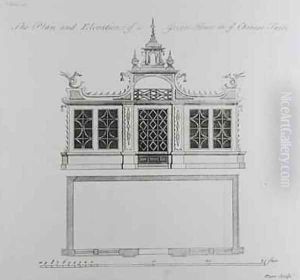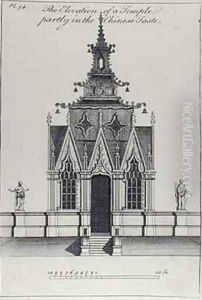Halfpenny, William Paintings
William Halfpenny, also known as Michael Hoare, was a British architect and carpenter known primarily for his work in the Georgian period. His exact birth date is not well-documented, but he was active during the mid-18th century. Halfpenny's work includes designs for buildings and garden structures, and he was particularly known for his contributions to the Chinoiserie style, which was popular in England during his time. This style was characterized by the use of fanciful Chinese motifs and elements in Western art and architecture.
Halfpenny's career was marked by the publication of a number of architectural pattern books, which were influential in disseminating Chinoiserie and other architectural styles throughout Britain and the American colonies. These books provided builders and craftsmen with plans and elevations for a variety of structures, from garden pavilions to bridges and greenhouses. Some of his well-known works include 'Rural Architecture in the Chinese Taste' (1750), 'New Designs for Chinese Temples' (1752), and 'The Chinese and Gothic Architecture Properly Ornamented' (1752).
Despite his contributions to the architectural landscape of the period, there is not a wealth of information on the specifics of Halfpenny's life or his training as an architect. It is suggested that he may have gained some of his architectural knowledge through travel, a common practice for architects of the time to study various styles and techniques. His use of the pseudonym Michael Hoare in some of his publications adds an element of mystery to his biography.
Halfpenny's death occurred in 1825, and although he may not be as well-remembered as some of his contemporaries, his work remains a testament to the eclectic tastes of the Georgian era and the desire to experiment with exotic architectural styles. His pattern books continue to be of interest to historians and architects studying the period's architectural history and the transmission of design ideas.

